The Intuition
When I stipulated that for aging persons “visiting old neighborhood, homes and school” is a comforting encounter point experience, it was something of an intuition based on my own experience and readings on the ecology of human development.
This intuition was recently revisited when, following some browsing in a flea market with my colleague BK, he decided on the spur of the moment to show me around those houses he had lived in from childhood to young adulthood that happened to be in the vicinity.
Seeing the possibility of exploring what associations he would be making now about these memory laden places, I asked him if he would agree to an interview regarding what I termed to be his “residential itinerary.”
His spontaneous response was: “You certainly have my attention and interest…I have all the notary paperwork…so I can date movements…I also have photographs.”
The Historical Context
“This was the far eastern edge of the city…” It was a little suburban town in the making, a place where you could go biking on dirt roads, walk across empty lots to visit neighbors, build your own house and eventually go skating on the frozen concrete surface of a highway under construction … it was the point zero of BK’s environmental memory … at age two!
“The neighborhood itself…the town of St Michel de Laval…” Stopped at the local main drag, with shops for daily needs, from which one walked to the nearest Montreal specialized shopping street, still known today for its clothing stores, or to the nearest trolley line to go to Old Montreal and its Central Market for special meat and poultry purchases, and from there, on occasion, to the main Amusement Park at the northern extremity of the trolley system. In BK’s words, these displacements were like “expeditions.”
“There was nothing there…” (ca 1949-60) There being the agricultural landscape between town and river that was soon to be developed with the building of the first east-west provincial highway tying together the various historical settlements on the island of Montreal and the expanding city of Montreal properly.
“We lived no more than ten to twenty minutes to where my father worked…” As can be expected, work being a key aspect of the process of integration, immigrants will try to find a place of residence near sources of employment and near the presence of other immigrants of the same origin.
The following chronological residential itinerary will eventually make manifest the social and cultural aspects of the relationship between workplace and residence, going from the Christmas paternalistic visit the business owner paid to his employees, to the use of some workplace equipment for moving and for building the home place, and to “the immigrant social circle formed around the Polish Mutual Aid Society.
Childhood: “We did a lot of moving…”
“I have no memory of the house on rue Gascon …” (ca 1949) Only what I was told by my parents: This was BK’s landing pad. They lived in one of the rooms occupied by other families.

“My father worked night shift, took the trolley bus two blocs away to and from the bakery, he baby sat me during the day, when my mother worked in the garment industry near downtown, and he would take me to the park across the street where he would fall asleep on a bench.”
“My memory is more vivid when we soon moved on rue Molson …” (ca 1949-51) closer to where his father worked. BK sketches a floor plan of the apartment shared again with two other families.
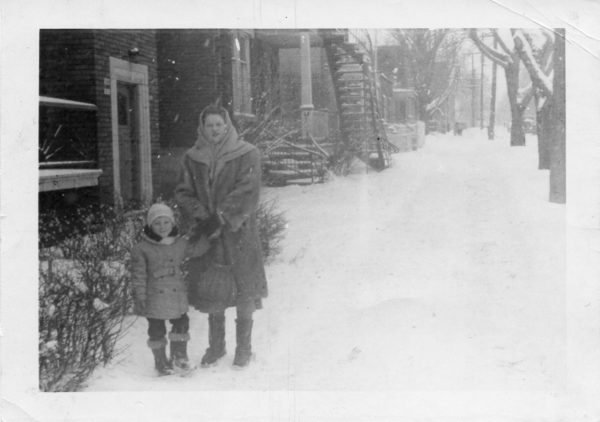
“We occupied one of the front rooms…for Polish people there was no such thing as a living room which was occupied by a family…I still have the furniture of our room with my teeth marks…”
“At Christmas time my father’s boss, referred to as the ‘old man’, would give a party and give gifts to the children. I remember getting a wheelbarrow I used to trundle along in the back alley, fill it with small stones and bring them to our backyard… I don’t remember doing anything with them… but I do remember a chicken being slaughtered in the backyard and left to spin until dead… I also remember getting a wooden erector set which ended up being played with by my parents and the other people in the house… I seemed to want the doll of a neighbor’s girl and made her fall to get it, until my mother relented and bought me one.”
Youth
“After the place on Molson we moved, using a bakery’s truck, to the one on 13th Ave…” (ca 1951-53)
An interesting detail here: the house was bought from an Italian fellow who accepted a black Leica IId as down payment, the camera having been traded in Germany against some tobacco products…this was right after the war!
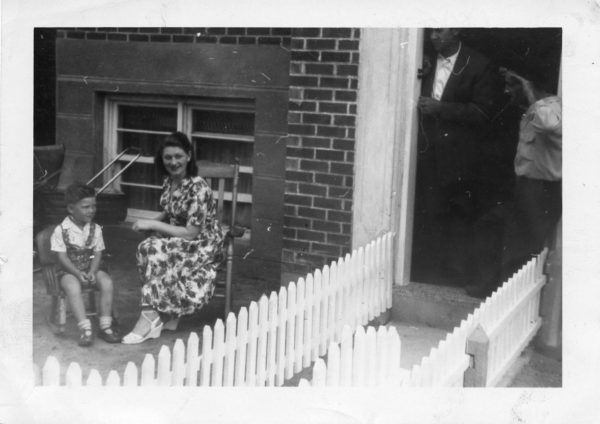
BK introduces his memories of the house on 13th Ave, ca 1951-53, as being his pre-school years: making friends in the street-neighborhood, riding a tricycle on the newly paved sidewalks, water playing in an old wash tub placed in the backyard, sliding on a snow packed slide built by his father, and helping his father with the shoveling of coal that had been delivered to a shed in the backyard.
It was the years of experiencing the various situations that can arise in a multifamily residential situation with his godparents arguing and fighting and eventually moving out, with the bachelor tenant “Stick” being absent in the fall to pick tobacco in Ontario, leaving BK to sleep in his room, which he did but under his bed, etc.
The years spent in that house allowed BK to experience the change of seasons in terms of different play activities, of clothing changes, of winter house heating and insulating, of summer play under shade trees, of making friends near and relatively far.
The last year or so on 13th Ave, BK was able to witness their small duplex being built on 12th Ave, the next street in the back, accessible through neighbors’ yards, with this or that neighbor providing a backhoe and a small crane for digging the foundations and pouring the concrete…BK pitching in to remove nails from concrete form work which was made of wood planks and not of plywood…and when the interior form work of the chimney had to be burnt, it caused quite a stir because of sparks flying off and threatening the neighboring houses.
In a real sense BK at five was pretty much socialized in terms of language, of making friends to play with and share toys and of having learnt to observe the adults and to relate to them. In other words, he was rather well prepared for school!
“My father was a contractor…” (ca 1953)
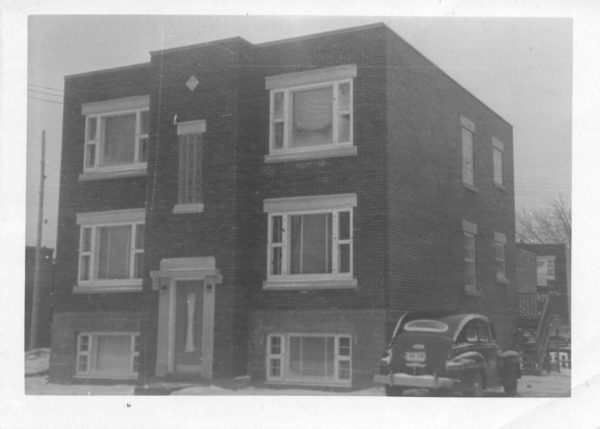
“A neighboring carpenter basically did all the rough carpentry…the building had two floors with two separate units each plus a basement with one unit…but my godparents expected to live with us (and not in a separate unit owned by my father) and that created a feud that lasted many years…”
BK draws a plan of the building showing the layout of each unit that had two rooms, a bath and kitchen, with his parents in the front room and BK in the other. When his sister was born she slept with his parents until he had completed gr. 5, by which time they had to move to a larger place with three rooms, close to BK’s gr. 6-7 school.
“Go see Mme Gagnon, she will give you breakfast and send you out to school…” (ca 1953-57) That was the night BK’s mother had to to be taken to the hospital to give birth to his sister, revealing the new set of mutual help relationships between choice neighbors living in separate single family units.
BK remembers finding out, through French national neighbors, the difference between international and Quebec French accents, learning to share center stage with his sister every neighbors wanted to see and welcome, learning to ride a rented two wheels bicycle, observing the social fauna on the street such as discovering a house of ill repute just two houses down, from the different kind of people staying there and others’ comings and goings…going to school and getting into new activities, new friends to whom he showed off his connections to the bakery through his father to get free donuts on occasions, accompanying his mother because he spoke French, etc.
“My mother spoke Polish, Ukrainian, German, Yiddish and elements of English but never learned to speak French…” (ca 1953-57) Making BK his de facto mother’s translator on shopping errands, giving him a certain status in the family when it was time to discover where the farthest reaches of the neighborhood met those of the city, as well as the more specialized shopping areas of the old city where the central meat and vegetable market was located, or on St Lawrence Blvd (The main north south artery where successive waves of immigrants first settled) where a lot of the Jewish stores were located and where a street car connected with the east-west trolleys.
At the time they left 12th Ave. the family owned two regular apartment buildings and was sponsoring his father’s sister to immigrate from Poland to Montreal. BK’s own sister had grown to the point that she needed a “room of her own”, so the family moved deeper into Ville St Michel on 9th Ave, by the new east west highway under construction, to be nearer BK’s gr. 6-7 school.
Adolescence
“The main difference between the house on 9th Ave and the previous ones were related to my age…” (ca 1957-60) That is the subjective part of it as BK was becoming autonomous enough to ride the bus and trolley by himself and had acquired a bicycle at Morgan’s department store, he rode on the unpaved back alley and eventually the suburban streets with his school mates. BK attended 5th to 7th grades in that house but in two separate schools because the move was made during the 5th grade school year.

“Playing in the back alley was strictly forbidden on Monday which was wash day per the best principles of home economics of the time…this allowed the drying of clothes on the clothes lines, which spanned over the back yard and alley, without getting dirtied from the dusty alley.”
The house was a three units duplex with garage, the bottom main unit had three bedrooms, living room, kitchen and bath plus an unfinished play room in the basement next to the garage which was rented to the upper unit tenant. The novelty of the living room accommodated a television and a weekly family and friends reunion to watch the first CBC TV series (La Famille Plouffe – produced in the two official languages) on the night it was broadcast in English.
Being close to a convent run by nuns for unwed mothers, which sat on a very large property mostly given to trees and shrubs, BK and friends had all they needed for exploration and cowboy and Indian games once they had cut an opening in the Frost fence surrounding the property!
“My friends were mostly school mates that did not necessarily live on 9th Ave…” which was even truer when BK reached high school, measuring over six feet in height, making him the youngest but also the tallest pupil!
This was then the last house in which he shared a bedroom with his sister, until his aunt moved out of the house ca 1959-60, thereby liberating a separate bedroom for his parents and the two children.
As the social life of BK became three tiered: family events at home, play with friends from school and community events at the Polish Hall, and, as the area around the house was building up with a regional shopping center and extended trolley and bus lines, with duplexes, triplexes and multi family apartment buildings, the neighborhood and the nearby city would become BK’S social horizon.
All these factors made it desirable to move one step closer to Montreal city limits for BK’s high school years, back on 13th Ave in a triplex building his father had scouted for roominess and for construction quality i.e. built during the spring to fall months for best behavior of the wood structure.
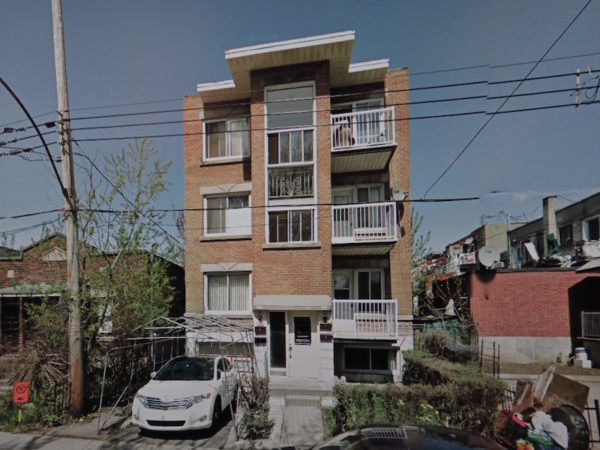
“The move to the house on 13th Ave was motivated for the social status associated with being close to the Montreal District of Rosemont…” (ca 1960-64) bout this time frame while on a family trip to Poland, the bakery where BK’s father worked was burned down after a period of economic decline and BK’s mother had left her place of employment in the garment industry near downtown, where her knowledge of Yiddish language and sewing skills had been central to her obtaining the job.
BK’s father obtained employment at a Montreal hospital’s sterilization service, affecting his presence in the house during the day, and his mother started working at home as a hat trim maker requiring a sewing room.
While in high school BK started on the basket ball team in the 2nd and 3rd year but his great height was unfortunately counterbalanced by poor ball handling skills, so by his 4th year he had become his school photographer … and this simply never stopped throughout his college years as student paper photographer and later as an art photography hobby implying the need for a dark room.
“Toward the end of the family stay in the house on 13th Ave, my parents comfortable financial situation and the changing needs for space by everybody in the household, made them seek physical comfort and the social standing of a Montreal address…and the consequent move to Rue Soubirous in Rosemont.”
Young Adulthood
The move to a duplex on Soubirous street was to usher BK’s into young adulthood and his sister into adolescence: his going to a Jesuit English college in the suburb of Montreal West prior to attending graduate school at a French university, and her attending a public religious High school in their new Rosemont neighborhood
“What was important for my parents as immigrants was that I go to school…I majored in economics to start with and when I came back from France during an exchange student program I majored in philosophy…and my father would not talk to me for a long time…”
By this time BK had turned his back on his old neighborhood, not out of snobbism but simply because the old neighbors were no longer there or he could meet them in school for those who did attend the same one he did.
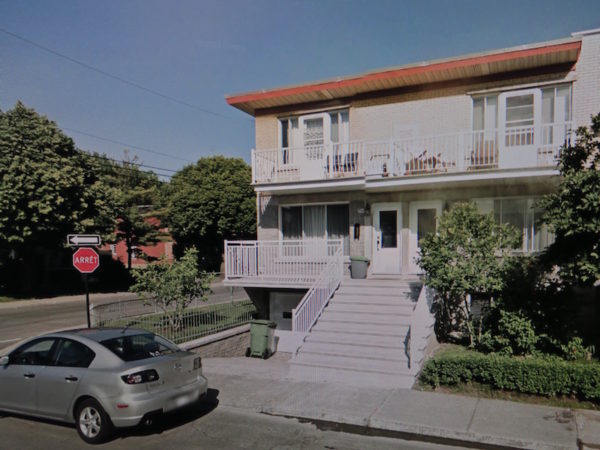
The house which was a duplex type had two units upstairs and a large one on the ground floor with three bedrooms, a living room, a kitchen and a bath, plus a garage and a play room in the basement.
It had all the “modern” conveniences, electric kitchen and washing equipment, television, a car Bk could drive to college at times; in other words, a level of material comfort that was to be obtained by working at a well remunerated occupation, hence the questioning of majoring in philosophy!
“I worked every summer at the Canadian Cooper Refinery east of Montreal and made enough money to pay tuition, books, clothes, etc.” It was labor work involving heavy machinery and critical chemical processing of large copper plates, things that sound like extremely strenuous work, as BK puts it, “when you are seventeen!”
Thinking back to his experience of helping his father with his building projects or event, working at his side in the bakery, BK sensed a continuity of technical and physical skills he best put this way:
“These events and experiences were my formation…made me in a sense who I am.”
Assessment
Did this exercise of remembering a residential itinerary feel good or comforting in any way?
On the one hand, while assessing the recalling of old homes and neighbors, BK notes that he was not the only one with parents that came out of the inferno of WW II, with the luck of having lived the post war years in a non-totalitarian environment allowing for free expression of desire for social justice and with the unspoken assumption that “finally fascism is over…that we now have to bear witness to its horrors and prevent it from happening again…and yet seeing what is happening around today…I am scared.”
On the other hand, while sensing that recalling as an “encounter point experience,” BK’s photographer’s eye and philosopher’s mind judged “that for me, your project has a very strong visual component, since each section corresponds to a lieu de residence, a structure that physically still exists, houses, schools, churches etc…I can see the sidewalk where I fell off the tricycle and ripped the side off my elbows, the place is there, I can see it…I remember it, I see it…That is the important factor for me.”
BK had answered the question in ways that on the whole confirmed my intuition: a city that can allow revisiting of old homes and schools can be comforting to an aging person for assessing the past, for sensing its continuity in the present and for its projection in the future with a project to visually document his “first sixteen years of residence” .
While wistfully remembering how often he had moved in those first sixteen years, and how socially frustrating it had been for him, BK notes that he has been living in his present house for the last twenty seven years!!
Vintage black and white images credit B. Karasek
All other photos credit Google maps
[alert type=alert-white ]Please consider making a tax-deductible donation now so we can keep publishing strong creative voices.[/alert]
